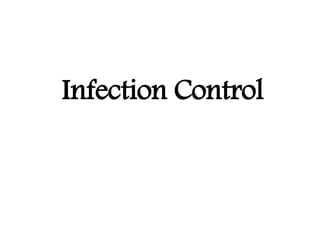
Concepts of infection control
- 2. Patient may acquire infection before admission to the hospital = Community acquired infection. Patient may get infected inside the hospital = Nosocomial infection. It includes infections not present nor incubating at admission, infections that appear more than 48 hours after admission, those acquired in the hospital but appear after discharge also occupational infections among staff. The risk of infection is always present.
- 3. INFECTION • Definition: Injurious contamination of body or parts of the body by bacteria, viruses, fungi, protozoa and rickettsia or by the toxin that they may produce. Infection may be local or generalized and spread throughout the body. Once the infectious agent enters the host it begins to proliferate and reacts with the defense mechanisms of the body producing infection symptoms and signs: pain, swelling, redness, functional disorders, rise in temperature and pulse rate and leucocytosis.
- 4. Frequency of Nosocomial Infection Nosocomial infections occur worldwide. The incidence is about 5-8% of hospitalized patients, 1/3 of which is preventable. A high frequency of N.I. is evidence of poor quality health service delivered.
- 5. Impact of Nosocomial Infections They lead to functional disability and emotional stress to the patient. They lead to disabling conditions that reduce the quality of life. They are one of the leading causes of death. The increased economic costs are high: Increased length of hospital stay (SSI - 8.2 days), extra investigations, extra use of drugs and extra health care by doctors and nurses.
- 6. Organisms causing N.I. can be transmitted to the community through discharged patients, staff and visitors. If organisms are multi- resistant they may cause significant disease in the community.
- 7. Nosocomial Infection Sites Urinary tract infection: most common type of N I (30-40% of reported cases), associated with an indwelling urinary catheter or instrumentation. Lower respiratory and surgical wound infections are the next ( each about 15%). Less frequent include bacteraemia (5%), intravenous site infection, gastrointestinal tract and skin infections.
- 8. Criteria of Nosocomial Infections Surgical site infection Any purulent discharge, abscess or spreading cellulitis at the surgical site during the month after operation Urinary infection Positive urine culture (1 or 2 species) with at least 100000 bacteria/ml, with or without clinical symptoms Respiratory infection Respiratory symptoms with at least 2 signs: cough; purulent sputum; new infiltrate on chest, appearing during hospitalization Vascular catheter infection Inflammation, lymphangitis or purulent discharge at the insertion site Septicaemia Fever or rigours and at least one positive blood culture
- 9. Factors Influencing N.I. The microbial agent Patient susceptibility Environmental factors
- 10. Microbial Agent Many sick people are treated in a closed area; micro-organisms, frequent contact between carriers & susceptible, contaminated waste, equipment and supplies to be handled. Developing of clinical disease depends on organism s virulence, infective dose and patient resistance
- 11. Bacteria are the most common pathogens. 1. Commensal bacteria: found in normal flora of healthy humans, prevent pathogenic bacterial colonization eg skin, colon, vagina 2. Pathogenic bacteria: have great virulence and cause infection as : - Anaerobic gram +ve rods e.g Clostridium causing gangrene. - Gram +ve bacteria: Staph. aureus found on skin &nose. - Beta -hemolytic Strep. - Gram -ve bacteria as E.coli, Proteus, Klebsiella. - legionella species.
- 12. Patient Susceptibility Age: infants and old age have decreased resistance to infection. Immune status: Patients with chronic diseases as malignancy, leukaemia, diabetes mellitus, renal failure or AIDS have increased susceptibility to infection. Immunosuppressive drugs or irradiation
- 14. Environmental Factors Healthcare settings are environment where both infected persons and persons at high risk of infection congregate. Crowded conditions within hospital, frequent transfers of patients between units. Microbial flora may contaminate objects, devices and materials which subsequently contact susceptible body sites of patients.
- 15. Transmission • Where do nosocomial infection come from? Endogenous infection: When normal patient flora change to pathogenic bacteria because of change of normal habitat, damage of skin and inappropriate antibiotic use. About 50% of N.I. Are caused by this way. Exogenous cross-infection: Mainly through hands of healthcare workers, visitors, patients.
- 16. Exogenous environmental infections: several types of micro-organisms survive well in the hospital environment (hospital flora): * In water, damp areas and occasionally in sterile products or disinfectants eg pseudomonas, Acinetobacter, Mycobacterium. * On items such as linen, equipment and supplies * In food. * In fine dust and droplet nuclei Some procedures that save life may increase risk of infection e.g urinary catheters, I.V.L inhalation therapy, surgery. Inappropriate use of antibiotics.
- 17. PROTECT YOURSELF THROUGH IMMUNISATION Immunisation BCG Hepatitis B Tetanus Rubella Varicella Influenza